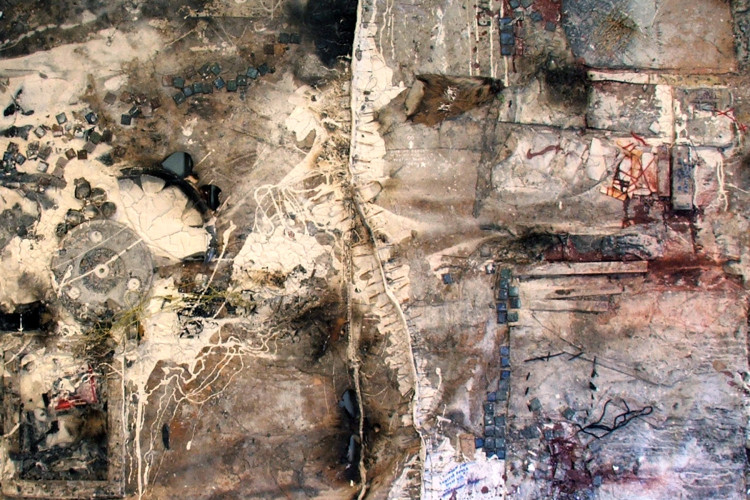James Robinson
Maker
16 June 2007 - 29 July 2007
James Robinson is well known to Dunedin and national audiences for turbulent, densely worked paintings in which the self and the world are constantly tussling. In his paintings from the early 2000s, webs of psychological pictograms compete for every spare inch of the canvas surface with outbursts of hand-painted text – provoking, imploring, confessing.
Maker feels like something new for Robinson. In this show for the Dunedin Public Art Gallery, he lets his materials do more of the talking than ever before, with results that complicate the common idea of his work as straightforwardly ‘Expressionist’. Robinson’s trademark cries and proclamations are still present, but you have to hunt for them amidst a surge of sheer stuff – a tumble of objects that includes shattered bottles, paint-pot lids, scissors, rope, firewood, and bathroom tiles, all held in place by gloopy white acrylic that is itself scarred and textured. Even the canvases are scavenged objects of a sort – older paintings that have been cut up and stitched back together like Frankenstein’s monster.
Putting broken and lowly things in a pristine gallery is Robinson’s way to get us wondering about value – about what is ‘waste’ and what is worth our attention. It’s an approach that goes back to assemblage artists such as Robert Rauschenberg and Don Driver, veteran scavengers and transformers of society’s spare parts. But the questions it raises are especially pressing today, when consumer objects are sold more aggressively and in greater quantities than ever before. Pitting himself against the smooth tasteful surfaces of this ‘designer world’, Robinson thrusts us into a realm of broken forms and unstable materials – a world that is materially ‘poor’ but rich in energy. In the process, he delivers a grungy retort to the clean-lined look of much recent art inspired by the virtual space of the computer screen.
These are landscape paintings, but of an intense and unusual kind. Where conventional landscape paintings usually offer long views out to a stable horizon, Robinson turns our gaze earthwards. With their crusty, evidence-rich surfaces, the paintings suggest archaeological cutaways, views into the surface of the earth. We see bits and pieces of the early twenty-first century, but altered so they resemble fragments of a long-gone civilization, corroded and impacted by time and geological pressure. The colours here are the colours of earth, oil, rust and mud. And by mounding some of the paintings with perishable fragments of the landscape, such as grass clippings, he provides us with an especially vivid reminder that artworks themselves change and perish over time.
The title offers a clue to Robinson’s drama of destruction and creation. Does the ‘maker’ of the title refer to the artist himself, as he works away at his surfaces? Or does it evoke the presence of some greater force churning away behind the chaotic world of these works? Should we feel daunted by this chaos, which often looks like an aftermath of some kind? Or marvel at the vitality and moments of unexpected beauty to be found within it? Robinson leaves the questions open, and in the process ensures that we viewers also play a crucial part as makers of these works.

